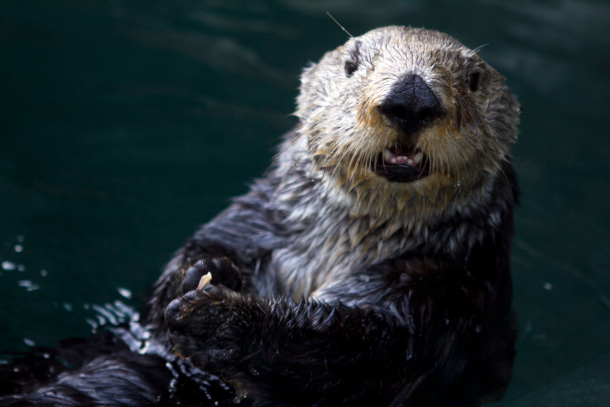Note on Emerging Science: Sea Otters Protect Alaskan Reefs
Air Date: Week of November 27, 2020

In Alaskan kelp reefs, otter populations help to keep sea urchin populations in check. (Photo: Canopic, Flickr, CC BY-NC-ND 2.0)
Sea otters are a textbook example of a keystone species: the health of the kelp forests they live among depends on these furry seafarers to keep kelp-eating sea urchins in check. New research shows that when sea otters aren’t around, sea urchins are even more destructive than previously known, tearing through the very reefs on which Alaskan kelp forests grow. Leah Jablo reports on the research and how it connects to climate change.
Transcript
CURWOOD: Just ahead why protecting the health of our planet is crucial to protecting our own human health but first this note on emerging science from Leah Jablo.
[SCIENCE NOTE THEME]
JABLO: New research published in the journal Science finds that sea urchins are destroying both carbon sequestering kelp and the coral bedrock beneath it, showing us how small animals can pack a big ecological punch.
[OTTER SOUNDS]
Animals like sea otters. The relationship between sea otters eat sea urchins is well known. A keystone species, sea otters eat sea urchins and keep their populations in check. But the population of sea otters has been in decline since the maritime fur trade of the seventeen and eighteen hundreds. Sea otters were hunted to near extinction and the population has never fully replenished- leaving the sea urchin population largely unchecked. They’ve already eaten through many Alaskan kelp forests, one of the world’s great carbon sinks.
But new research finds that urchins are now tearing through more than just the kelp forests. With few otters around to eat them, sea urchins are now eating away at what lies beneath the kelp: coral-like limestone reefs made up of red algae.
These luminous, bright-red, rocky reefs that lie on the Alaskan seafloor form the very foundation of its kelp forest ecosystem, and like much life in the ocean they’re also threatened by ocean acidification. Acidic conditions are making it harder for the reef algae to calcify, and form its protective limestone skeleton which deters sea urchins.
Ecologists say that the survival of these Alaskan reefs and the kelp forests above them all depends on the return of their furry keystone predators.
[OTTER SOUNDS]
In a small way, bringing back sea otters may help slow the warming of our planet, and help restore the ocean ecosystems they’re a vital part of.
CURWOOD: That’s this week’s note on emerging science, I’m Leah Jablo.
Links
Read more on otter research at the Bigelow Lab of Ocean Sciences
Living on Earth wants to hear from you!
Living on Earth
62 Calef Highway, Suite 212
Lee, NH 03861
Telephone: 617-287-4121
E-mail: comments@loe.org
Newsletter [Click here]
Donate to Living on Earth!
Living on Earth is an independent media program and relies entirely on contributions from listeners and institutions supporting public service. Please donate now to preserve an independent environmental voice.
NewsletterLiving on Earth offers a weekly delivery of the show's rundown to your mailbox. Sign up for our newsletter today!
 Sailors For The Sea: Be the change you want to sea.
Sailors For The Sea: Be the change you want to sea.
 The Grantham Foundation for the Protection of the Environment: Committed to protecting and improving the health of the global environment.
The Grantham Foundation for the Protection of the Environment: Committed to protecting and improving the health of the global environment.
 Contribute to Living on Earth and receive, as our gift to you, an archival print of one of Mark Seth Lender's extraordinary wildlife photographs. Follow the link to see Mark's current collection of photographs.
Contribute to Living on Earth and receive, as our gift to you, an archival print of one of Mark Seth Lender's extraordinary wildlife photographs. Follow the link to see Mark's current collection of photographs.
 Buy a signed copy of Mark Seth Lender's book Smeagull the Seagull & support Living on Earth
Buy a signed copy of Mark Seth Lender's book Smeagull the Seagull & support Living on Earth

